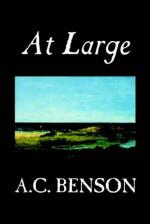Then further still by a lonely ill-laid road. And thus, with a mind pleasantly attuned to beauty and a quickening pulse, I drew near to Kelmscott. The great alluvial flat, broadening on either hand, with low wooded heights, “not ill-designed,” as Morris said, to the south. Then came a winding cross-track, and presently I drew near to a straggling village, every house of which had some charm and quality of style, with here and there a high gabled dovecot, and its wooden cupola, standing up among solid barns and stacks. Here was a tiny and inconspicuous church, with a small stone belfry; and then the road pushed on, to die away among the fields. But there, at the very end of the village, stood the house of which we were in search; and it was with a touch of awe, with a quickening heart, that I drew near to a place of such sweet and gracious memories, a place so dear to more than one of the heroes of art.
One comes to the goal of an artistic pilgrimage with a certain sacred terror; either the place is disappointing, or it is utterly unlike what one anticipates. I knew Kelmscott so well from Rossetti’s letters, from Morris’s own splendid and loving description, from pictures, from the tales of other pilgrims, that I felt I could not be disappointed; and I was not. It was not only just like what I had pictured it to be, but it had a delicate and natural grace of its own as well. The house was larger and more beautiful, the garden smaller and not less beautiful, than I had imagined. I had not thought it was so shy, so rustic a place. It is very difficult to get any clear view of the Manor. By the road are cottages, and a big building, half storehouse, half wheelwright’s shop, to serve the homely needs of the farm. Through the open door one could see a bench with tools; and planks, staves, spokes, waggon-tilts, faggots, were all stacked in a pleasant confusion. Then came a walled kitchen-garden, with some big shrubs, bay and laurustinus, rising plumply within; beyond which the grey house, spread thin with plaster, held up its gables and chimneys over a stone-tiled roof. To the left, big barns and byres—a farm-man leading in a young bull with a pole at the nose-ring; beyond that, open fields, with a dyke and a flood-wall of earth, grown over with nettles, withered sedges in the watercourse, and elms in which the rooks were clamorously building. We met with the ready, simple Berkshire courtesy; we were referred to a gardener who was in charge. To speak with him, we walked round to the other side of the house, to an open space of grass, where the fowls picked merrily, and the old farm-lumber, broken coops, disused ploughs, lay comfortably about. “How I love tidiness!” wrote Morris once. Yet I did not feel that he would have done other than love all this natural and simple litter of the busy farmstead.
Here the venerable house appeared more stately still. Through an open door in a wall we caught a sight of the old standards of an orchard, and borders with the spikes of spring-flowers pushing through the mould. The gardener was digging in the gravelly soil. He received us with a grave and kindly air; but when we asked if we could look into the house, he said, with a sturdy faithfulness, that his orders were that no one should see it, and continued his digging without heeding us further.




